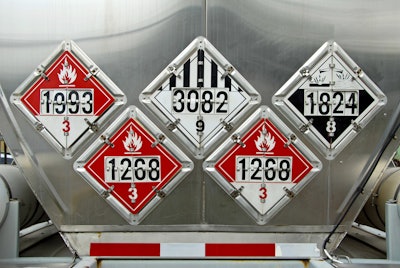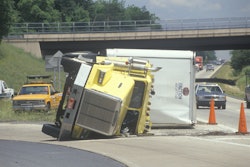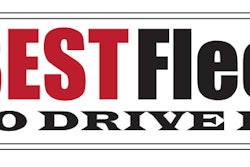
A recent unannounced five-day inspection blitz in the U.S. and Canada found 1,774 violations of regulations regarding hazardous materials/dangerous goods.
On June 13-17, commercial motor vehicle inspectors checked 6,204 vehicles transporting hazardous materials/dangerous goods and 6,668 HM/DG packages in Canada and the U.S. for an initiative for the Commercial Vehicle Safety Alliance.
Vehicles found to have HM/DG-related out-of-service violations, and/or any other driver or vehicle out-of-service violations, were restricted from traveling until all out-of-service violations were addressed.
According to a statement from the CVSA, during the 2022 HM/DG Road Blitz, inspectors discovered the following violations:
- 408 shipping papers violations
- 269 non-bulk/small means of containment packaging violations
- 272 bulk packaging/large means of containment placarding violations
- 76 non-bulk/small means of containment labeling violations
- 159 bulk packaging/large means of containment placarding violations
- 79 other safety marks violations
- 168 loading and securement violations
- 43 HM/DG package integrity (leaking) violations
- 84 transportation of Dangerous Goods Training Certificate violations (Canada only)
A summary of the HM/DG class types inspected in the U.S. found:
- Class 1: Explosives, such as ammunition, fireworks, flares, etc.150
- Class 2: Gases, flammable, non-flammable oxygen, and inhalation hazards1,343
- Class 3: Flammable and combustible liquids, such as fuel oil, acetone, adhesives, paints, gasoline, ethanol, methanol, some pesticides, etc. 2,962
- Class 4: Flammable solids, substances liable to spontaneously combust, and substances that, on contact with water, emit flammable gases, such as white phosphorus and sodium 331
- Class 5: Oxidizing agents and organic peroxides, such as hydrogen peroxide, potassium permanganate, sodium nitrite, ammonium nitrate fertilizers, and oxygen generators 179
- Class 6: Toxic and infectious substances; any material, other than a gas, that is so toxic to humans that it presents a health hazard during transportation, such as cyanide, biological samples, clinical wastes, and some pesticides 119
- Class 7: Radioactive materials, such as cobalt 60 and cesium 19
- Class 8: Liquid or solid corrosive substances, such as sulfuric acid and sodium hydroxide, that cause full thickness destruction of human skin at the site of contact within a specified time 921
- Class 9: Miscellaneous HM/DG, such as acetaldehyde ammonia, asbestos, elevated temperature materials, and benzaldehyde 369
Governments in Canada and the U.S. have strict inspection and enforcement programs to ensure compliance with regulations regarding the transportation of HM/DG. In the U.S., the Pipeline and Hazardous Materials Safety Administration and the Federal Motor Carrier Safety Administration are responsible for regulating and ensuring the safe and secure movement of hazardous materials.
According to FMCSA’s data for the last calendar year (as of Aug. 26, 2022), the top five hazmat violations in the U.S. were:
- Package not secure in vehicle
- No copy of USDOT HM registration number
- No or improper shipping papers (carrier)
- Shipping paper accessibility
- Vehicle not placarded as required









